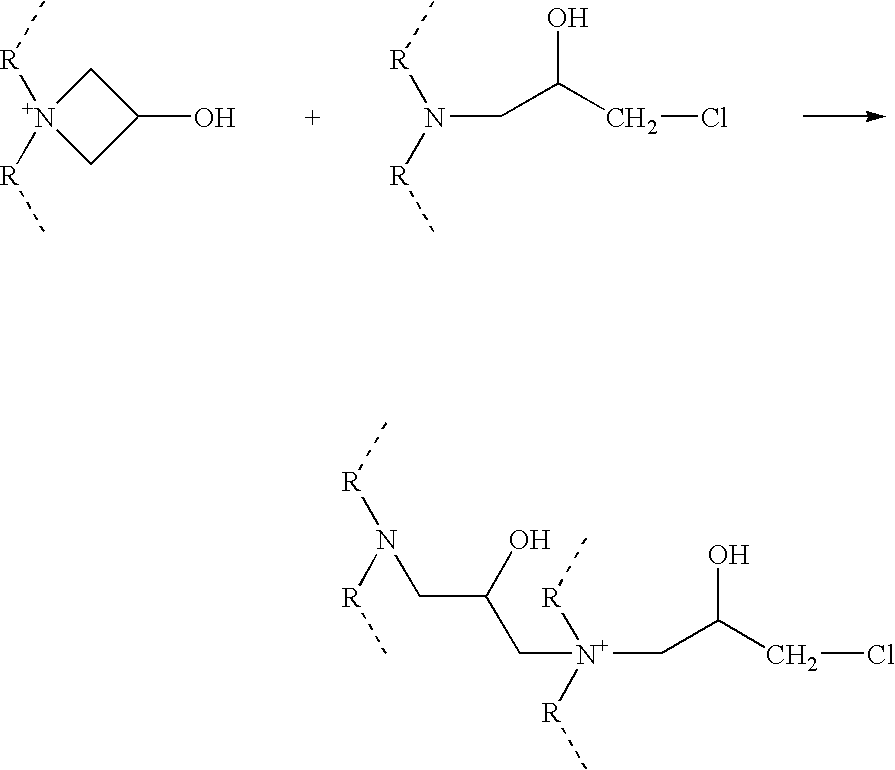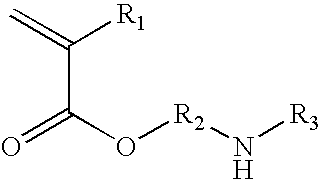Azetidinium modified polymers and fabric treatment composition
- Summary
- Abstract
- Description
- Claims
- Application Information
AI Technical Summary
Benefits of technology
Problems solved by technology
Method used
Image
Examples
example 1
Preparing Aminoethylmethacrylate Hydrochloride
A 500 ml 2 neck round bottomed flask was charged with 2-aminoethanol hydrochloride (46.2 g, 0.47 m) and methacryloyl chloride (49.11 g, 0.47 mols). To this hydroquinone (1 mol %, 0.5 g) was added to prevent polymerisation. The fused mass was then heated to 85-100° C. with cautious stirring until no more hydrogen chloride evolved (12 h). The amino ester hydrochloride formed was recrystallised from dry dichloroethane and vacuum dried to give a white crystalline solid (63 g, 84%).
(δH 500 MHz; CDCL3) 1.95 (3H, s, CH3) 3.66 (2H, m, —CH2—) 4.5 (2H, t, J 5 Hz, —CH2—) 5.62 (H, s, vinyl CH) 6.27 (H, s, vinyl CH) 8.38 (3H, bs, NH3+).
example 2
Polymerising Aminoethylmethacrylate Hydrochloride with Oligoethyl-Methacrylate Monomethyl Ether (M.wt. 430) 1:1 Molar Ratio
Aminoethylmethacrylate hydrochloride (5 g, 0.03 mols, 1 equivalent), oligoethylmethacrylate monomethyl ether (M. wt. 430) (13 g, 0.03 mols 1 equivalent) and AIBN (0.18 g, 1% w / w) were dissolved in water (180 ml). The solution was degassed via the freeze-pump-thaw method and purged with nitrogen. The flask was sealed and the solution stirred with heating at 80° C. for 12 hours. The polymer solution was then freeze dried and the polymer re-dissolved in THF. This organic solution was then added dropwise to vigorously stirring chilled (−20° C.) hexane to give the polymer as a white precipitate. The precipitate was then filtered off and washed with a further amount of chilled non-solvent to give a clear sticky polymer (16.9 g, 94%).
example 3
Functionalisation with Epichlorohydrin
The previously prepared polymer of example 2 (2 g, 2.88 mmol equivalents based on amine level) was dissolved in water (20 ml) and basified with NaOH solution until pH 10. Epichlorohydrin (0.27 g, 2.88 mmols, 1 equivalent) was added to the solution and stirring was continued at room temperature for either 2 or 4 hours before the solution was acidified with HCl solution to pH 4.
PUM
| Property | Measurement | Unit |
|---|---|---|
| Concentration | aaaaa | aaaaa |
| Adsorption entropy | aaaaa | aaaaa |
Abstract
Description
Claims
Application Information
 Login to View More
Login to View More - R&D
- Intellectual Property
- Life Sciences
- Materials
- Tech Scout
- Unparalleled Data Quality
- Higher Quality Content
- 60% Fewer Hallucinations
Browse by: Latest US Patents, China's latest patents, Technical Efficacy Thesaurus, Application Domain, Technology Topic, Popular Technical Reports.
© 2025 PatSnap. All rights reserved.Legal|Privacy policy|Modern Slavery Act Transparency Statement|Sitemap|About US| Contact US: help@patsnap.com



